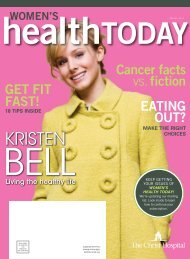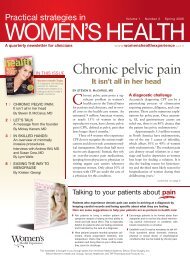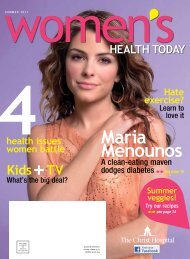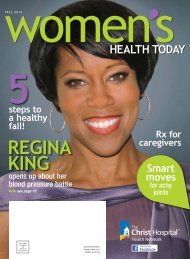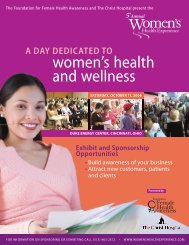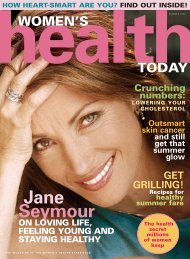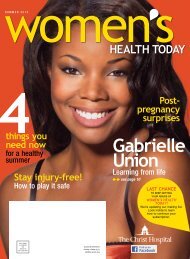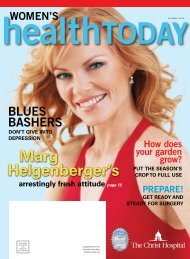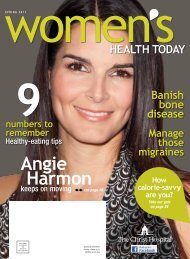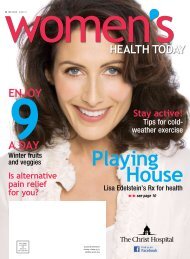Catherine Bell - The Christ Hospital
Catherine Bell - The Christ Hospital
Catherine Bell - The Christ Hospital
You also want an ePaper? Increase the reach of your titles
YUMPU automatically turns print PDFs into web optimized ePapers that Google loves.
F a l l 2 0 0 9women’shealthtodayAdios,achoosFight the flu<strong>Catherine</strong><strong>Bell</strong> having funwith the family page 10Wantfab abs?Try theseeasy movesFoolprooffood advice<strong>The</strong> <strong>Christ</strong> <strong>Hospital</strong>2139 Auburn AvenueCincinnati OH 45219non-profit orgus postagePaidcincinnati ohPermit #5489
Two of Cincinnati’sMost PreferredImproving the Health of the Community<strong>The</strong> <strong>Christ</strong> <strong>Hospital</strong> and Cincinnati Sports Club are partnering togetherto help improve the overall health of Greater Cincinnati residents. We’rebringing the health care expertise of Cincinnati’s Most Preferred hospitalto one of the Midwest’s top health and fitness facilities – encouragingeveryone to enjoy an active, healthy lifestyle.Together, we offer a wide range of health screenings, educationalseminars and wellness programs at the Club. For a list of upcomingevents, screenings and seminars, or for more information, visitwww.CincinnatiSportsClub.com or www.<strong>The</strong><strong>Christ</strong><strong>Hospital</strong>.comor call 513-527-4000.Cincinnati Sports ClubTwo Convenient Entrances3950 Red Bank RoadOr5535 Murray AvenueCincinnati, OH 45227513-527-4000
women’shealthtodayF A L L 2 0 0 9in this issue . . .2 L E T T E R F R O M T H E F O U N D E RFollow these directions!3 Could a clinical trial help you?4 Healing chronic woundsProtein plays an important role5 Don’t suffer from uterine fibroidsNonsurgical treatment can help6 H E A L T H H E A D L I N E SWhat’s making news in women’s health88 Troubled watersProtect yourself from UTIs9 S E X & G E N D E R M A T T E R SMigraines, pregnancy and strokeWhat’s the connection?10 Candid <strong>Catherine</strong>!Actress <strong>Catherine</strong> <strong>Bell</strong> enjoys a kinder, gentler lifestyle14 H E A L T H Y B I T E S8 steps to healthy holiday eating<strong>The</strong>se strategies work!1616 Rx for troubleNot taking your meds as directed18 Seasonal heart dangers!Don’t fall victim to these health hazards20 Beat arthritis painDrug-free ways to feel better21 Foiling the fluSimple steps to stop the spread22 H E A L T H Y M O V E SWant fab abs?Use these moves for a tauter tummy24 H E A L T H S M A R T SAlcohol pop quiz20www.womenshealthexperience.com
Letter from the founderwomen’shealthtodayt h e m a g a z i n e o ft h e f o u n d a t i o n f o r f e m a l e h e a l t h a w a r e n e s sFollow these directions!We’re all surrounded by signs, messages and signals telling us whereto turn, what door to open, what food to buy … the list goes on andon. If you’re like me, you may feel society continually tells you whatto do, and you get a secret thrill from breaking little rules now and then. Butdirections do need to be followed when it comes to your health and medications.Read “Rx for trouble” on page 16 to learn how you can better follow yourphysician’s prescription recommendations and how to avoid prescription drugdependence, if that’s your concern.In this issue of Women’s Health Today, you’ll also find timely advice to helpyou avoid seasonal weight gain. <strong>The</strong> strategies offered in “8 steps to healthyholiday eating” on page 14 really do work—all it takes is a little thought andplanning. With the autumn and winter months upon us, you’ll also want tolearn how to fend off the flu. <strong>The</strong> tips in “Foiling the flu” on page 21 can helpkeep you and your family influenza-free this winter.<strong>The</strong>se are just a few of the wide-ranging health topics in this issue ofWomen’s Health Today. I hope you find them all informative and useful. We aimto provide you with a variety of up-to-date and easy-to-understand articles witheach issue; let me know what other topics you’d like to read about. I’d love tohear from you!F o u n d e r sMickey M. Karram, MD / Mona KarramN a t i o n a l A d v i s o r y B o a r dLinda Brubaker, MD, Professor of Obstetrics and Gynecology,Urogynecology Urology, Loyola University Chicago Stritch Schoolof Medicine; Co-Director, Women’s Pelvic Medicine Center,Loyola University Medical CenterVivien K. Burt, MD, PhD, Associate Professor of Clinical Psychiatry,<strong>The</strong> David Geffen School of Medicine at UCLA; Founder and Director,Women’s Life Center, UCLA Neuropsychiatric Institute and <strong>Hospital</strong>Vivian M. Dickerson, MD, Associate Clinical Professor ofObstetrics and Gynecology, University of California Irvine; Director,Division of General Obstetrics and Gynecology, UCI Medical Center;Director of UCI’s Post Reproductive Women’s Integrative Health CenterTommaso Falcone, MD, Professor and Chairman, Departmentof Gynecology and Obstetrics, <strong>The</strong> Cleveland Clinic Foundation;Co-Director, Center for Advanced Research in Human Reproductionand InfertilitySebastian Faro, MD, PhD, Clinical Professor of Obstetrics andGynecology, Women’s <strong>Hospital</strong> of TexasNieca Goldberg, MD, Assistant Professor of Medicine,SUNY Health Science Center, Brooklyn, New York;Clinical Assistant Professor of Medicine, New York UniversityThomas Herzog, MD, Professor of Clinical Obstetrics andGynecology, Columbia University College of Physicians and Surgeons;Director, Division of Gynecologic Oncology, Columbia UniversityMedical Center, New YorkBarbara Levy, MD, Medical Director, Women’s Health & BreastCenter, St. Francis <strong>Hospital</strong>, Federal Way, Washington; AssistantClinical Professor of Obstetrics & Gynecology, Yale University Schoolof Medicine; Assistant Clinical Professor of Obstetrics and Gynecology,University of Washington School of MedicineWendy l. wright, ARNP, FAANP, Adult/Family NursePractitioner; Adjunct Faculty, Fay W. Whitney School of Nursing,University of WyomingT h e C h r i s t H o s p i t a l S T A F FPresident and CEO Susan CroushoreChief Operating Officer Victor DiPillaChief Nursing Officer Deborah HayesChief Marketing Officer Heather AdkinsChief Medical Officer Berc Gawne, MDEditor Arin Kraemerc u s t o m e r s e r v i c eFor more information about services at <strong>The</strong> <strong>Christ</strong> <strong>Hospital</strong>,please contact Arin Kraemer at arin.kraemer@thechristhospital.com or(513) 585-3945.Women’s Health Today is published four times a year by<strong>The</strong> <strong>Christ</strong> <strong>Hospital</strong>, 2139 Auburn Avenue, Cincinnati, OH 45219,in conjunction with the Foundation for Female Health Awareness,PO Box 43028, Cincinnati, OH 45243. This is Volume 5, Issue 4.© 2009 by <strong>The</strong> <strong>Christ</strong> <strong>Hospital</strong> and the Foundation forFemale Health Awareness. All rights reserved.Mickey M. Karram, MDPRESIDENT AND Co-FounderFoundation for Female Health AwarenessDr. Karram and his wife, Mona, are the founders of the Foundation for Female HealthAwareness, a nonprofit organization dedicated to improving women’s health by supportingunbiased medical research and educating women about their health.<strong>The</strong> information contained herein is not a substitute for professionalmedical care or advice. If you have medical concerns, seek theguidance of a healthcare professional.Women’s Health Today magazine is part ofWomen’s Health Experience, the flagship program of theFoundation for Female Health Awareness. Women’s Healthrecycle-logo_2options_v2.aiExperience is a unique initiative aimed at connecting women withhealthcare experts, as well as their local hospitals, to learn aboutimportant issues that may affect their health. Through Women’sHealth Experience, Women’s Health Today magazine andwww.womenshealthexperience.com, you’ll get objective, timelyinformation. You can also sign up for free e-newsletters containinghealth news Printed With and Soy Inkresults Printed of With medical Soy Ink studies.Sign up now at www.womenshealthexperience.com.Please Recycle This PublicationWomen’s Health Todayc o v e r : C at h e r i n e B e l l© M a r k Please R oy cRecycle e / C o r bThis i s OPublicationu t l i n ePrinted With Soy InkPlease Recycle This PublicationPrinted With Soy Ink
Healing chronic woundsProtein plays an important roleBy Rank Dawson, Jr., MD, FACSAs humans, our biological priorities are oxygen,protection from temperature extremes,water and nourishment. Most people andcaregivers have a good understanding of thefirst three but may not understand the complexities ofnourishment. This misunderstanding can have seriousresults in people who have chronic wounds.What is catabolism?In the state of catabolism, a person’s energy consumptionis greater than his or her caloric intake for24 hours, causing the body to burn stored energy,protein and micronutrients. Catabolism can sometimesbe triggered by a chronic wound, one whichgenerally hasn’t healed within eight weeks. A chronicwound can weaken a person’s nutritional state becauseof the wound’s nutritional healing needs and thedirect loss of nutrition through the wound’s drainage,however small. This increase in the body’s fuel needsmay be greater than the nutrition available and canresult in the body becoming depleted and catabolic.At this point, the body can no longer respond to theincreased needs to promote wound healing.Catabolism doesn’t cause serious harm overa short period of time. However, in the case of achronic wound, when this process continues it canoften lead to serious problems, including urinary tractinfection, pneumonia, skin breakdown in other areasof the body and muscle weakness. <strong>The</strong>se conditionsare further aggravated by protein loss, contributing tooverall declining health and an increased risk of sepsisand death.<strong>The</strong> importance of proteinWith a better understanding of the critical roleprotein nutrition plays in wound healing and diseaseprevention, you can better adjust your diet andimprove your future health.Eating enough protein on a regular basis canprevent some of the problems that occur with woundhealing. If you’re seriously injured, you should discusswith your physician taking oral supplements inaddition to increasing your dietary protein intake. Ifyour protein needs exceed your ability to eat, temporarytube feedings may be necessary. WHT© istockphoto.com/Elena ElisseevaWe’ll help you heal!Do you have a wound that won’t heal? <strong>The</strong> experts at<strong>The</strong> <strong>Christ</strong> <strong>Hospital</strong> Wound Healing Center are availablefor consultation. Call 513-585-4595 to learn more.Rank Dawson, Jr., MD, FACS, is a plastic surgeon at <strong>The</strong> <strong>Christ</strong> <strong>Hospital</strong>.Women’s Health Today
By Daniel E. Long, MDDon’t suffer fromuterine fibroidsNonsurgical treatment can helpUterine fibroids affect 20 percent to40 percent of women ages 35 and older.<strong>The</strong>se noncancerous growths develop inthe muscular uterus wall, and while theyusually don’t have symptoms, they can cause heavybleeding, prolonged monthly periods and extremepain—symptoms that can have a significant impact ona woman’s life.During UFE, an interventionalradiologistinserts a catheter intoan artery through asmall incision at thetop of the thigh (above).Using X-ray technology,small particles areinjected into the artery(left), blocking bloodflow to the fibroid,causing it to shrink.Illustration provided by Biosphere Medical, Inc.Shrinking fibroidsUterine fibroid embolization (UFE) is a nonsurgicalalternative to myomectomy (surgical fibroidremoval) and hysterectomy (surgical uterus removal)to treat fibroids. During UFE, the patient is sedatedand an interventional radiologist—a board-certifiedphysician who specializes in minimally invasive, targetedtreatments—inserts a catheter into an arterythrough a small incision at the top of the thigh.Using X-ray technology, small particles are injectedinto the artery, which block the flow of blood to thefibroid, causing it to shrink. Improvement of symptomsoccurs, usually within one to two menstrualcycles. Fibroids shrink by at least 60 percent andcontinue to reduce in size for up to a year.<strong>The</strong> entire UFE procedure usually takes less thanan hour. Some women can go home the same day;others remain in the hospital overnight for observationand to be treated for any discomfort. Many womenresume light activities in a few days, and the majority areable to return to normal activities within a week.Of women treated at <strong>The</strong> <strong>Christ</strong> <strong>Hospital</strong> forfibroids, about 90 percent who had excessive bleedingand 85 percent who had pelvic pressure, bloating andurinary frequency have had a significant decrease inpersistent symptoms.Is UFE for you?UFE patients enjoy shorter hospital stays, fasterrecovery periods and fewer complications thanhysterectomy patients. Because it uses a minimallyinvasive technique, UFE can safely treat women withother health problems. Your gynecologist and interventionalradiologist can help you decide if UFE isright for you. Ideal candidates include women pastchildbearing age who have troublesome symptomsand want to avoid hysterectomy. WHTFight fibroids!Board-certified diagnostic radiologists Daniel E. Long,MD; Joseph Bernstein, MD; and James Traiforos, MD,are here to help. To learn more about UFE or to schedulean appointment with one of our physicians, call<strong>The</strong> <strong>Christ</strong> <strong>Hospital</strong> at 513-585-1000.Daniel E. Long, MD, is medical director of interventional radiology at <strong>The</strong> <strong>Christ</strong> <strong>Hospital</strong>.www.womenshealthexperience.com
what’smaking newsin women’shealthhealthheadKeeping fit improvesyour memory<strong>The</strong> hippocampus—the part of the brainthat’s necessary for certain types ofmemory—shrinks as we get older. But anew study from the University of Illinoisand the University of Pittsburgh finds thatexercise may overcome the brain shrinkage.Researchers tested the fitness levels of 165Hot tea poseshigher riskmen and women between the ages of 59 and 81. <strong>The</strong>y also analyzed bothsides of the hippocampus and tested participants’ spatial memory, andfound a major link between fitness level, hippocampus size and performanceon memory tests. Those who were more physically fit had a biggerhippocampus than those who were less fit. <strong>The</strong> message: Keep workingyour body to keep your brain working as you age.Like your tea steaming hot? You may want to letit cool down a bit before you sip. A new study inBMJ says that drinking tea that’s too hot may makeesophageal cancer more likely. Researchers studiedtea drinkers in northern Iran, which has a high rateof esophageal squamous cell carcinoma. <strong>The</strong>y interviewed300 people with the cancer and 571 healthypeople. <strong>The</strong> participants answered questions abouttheir tea-drinking habits, including how hot they usuallydrank their tea (very hot, hot, warm or lukewarm)and how long they let the tea sit before drinking it.Nearly all participants—98 percent—said they dranktea daily. Those who drank their tea very hot wereeight times more likely to develop esophageal cancerthan warm or lukewarm tea drinkers were. <strong>The</strong>problem is not the tea but theinflammation that occurswhen you drink it toohot. To save youresophagus, let allhot drinks cool offfor at least four minutesbefore sipping.© 2009 JupiterimagesWomen’s Health Today
sex & Gender matters<strong>The</strong> latest findings on women-specific healthfrom the Society for Women’s Health ResearchBy Sarah Keitt, MPHMigraines,pregnancy& strokeWhat’s the connection?For many women who suffer frommigraines, pregnancy can be a periodof relief from their headaches. Studies havefound that preexisting migraines diminishor disappear in 42 percent to 98 percent of pregnantwomen. However, new, persistent or worseningmigraines during pregnancy can signal a seriousproblem that could result in a stroke. A study recentlypublished in BMJ found that migraines were associatedwith a 15-fold increase in pregnancy-related stroke.A stroke, or brain attack, occurs when bloodflow to the brain is disrupted either by a blockage (anischemic stoke) or by bleeding in the brain (a hemorrhagicstroke), causing brain-cell death and braindamage. For young women, stroke is a rare phenomenon,occurring in fewer than 11 of 100,000 womeneach year.Stroke risk factorsPregnant women, however, have a three- to13-fold increase in their stroke risk. Risk factors forpregnancy-related stroke include:• abnormal blood clotting• alcohol and substance abuse• multiple gestations (twins, triplets, etc.)• diabetes• heart disease• high blood pressure• history of migraine headache• caesarean section• older maternal age• smoking• vasoreactivity (changes in the functionof blood vessels to the brain)What to do?What does this mean for a pregnant womanwith either a history of migraines or a new onsetof migraines with her pregnancy? More research isneeded to fully understand the risks of migrainesduring pregnancy. In the meantime, pregnant womenshould make their physician aware of their migrainehistory. Abnormal clotting can be treated with bloodthinners, and pregnant women with migraines canbe monitored closely for preeclampsia, a potentiallylife-threatening condition characterized by high bloodpressure and protein in the urine.For women who do suffer a pregnancy-relatedstroke, no data suggests a risk of recurrent stroke insubsequent pregnancies. However, women who’ve hada stroke and are contemplating another pregnancyshould be assessed for treatable risk factors. WHTLearn more!<strong>The</strong> Society for Women’s Health Research is a nonprofit research,education and advocacy organization that works to improve women’shealth through sex-specific research, education and advocacy.To find this article and more of the latest news and research onwomen’s health, visit www.womenshealthresearch.org.Sarah Keitt, MPH, is program manager for the Society for Women’s Health Research in Washington, D.C.www.womenshealthexperience.com
10Women’s Health Today© Getty Images / Jeff Olson
Candid<strong>Catherine</strong>!Actress <strong>Catherine</strong> <strong>Bell</strong> enjoys a kinder, gentler lifestyleBy Bonnie Siegler<strong>Catherine</strong> <strong>Bell</strong>, a self-described “tough chick,” is happyexploring new territory on screen and off. While manyadmired the exotic actress as hard-hitting Marine Corpsattorney Lt. Col. Sarah ‘Mac’ MacKenzie on “JAG” for10 seasons, <strong>Bell</strong> has since segued into the gentler role of motherDenise Sherwood, an Army nurse emerging from her shell onLifetime’s hit drama “Army Wives.” Offscreen, she’s settled intoa more leisurely lifestyle at her restored 19th-century home inCharleston, S.C.—where “Wives” films—with screenwriter husbandAdam Beason and 6-year-old daughter, Gemma. <strong>Bell</strong> and Beasononce enjoyed skydiving, bungee jumping and hopping on one oftheir nine motorcycles, but now that she’s a mom, Pilates, golf andwakeboarding have taken center stage. “I used to like taking risks,”admits <strong>Bell</strong>, “but I wasn’t an adrenaline junkie; I took safety seriously.I’m just a firm believer in living life to the fullest and tryingeverything at least once. I love life, no matter what I’m doing.”continued on page 12 >>www.womenshealthexperience.com 11
continued from page 11Switching gearsBeing mom to Gemma is what’s responsible for<strong>Bell</strong>’s kinder, gentler approach to life. “Motherhoodhas changed my life so much. Gemma has made merealize how much fun it is to be a kid, with that innocentsense of wonder and excitement. Now I blow<strong>Bell</strong> (second from left) with “Army Wives” costars Drewoff steam and get excited playing golf,” <strong>Bell</strong> laughs. Fuller, Brigid Brannagh and Kim DelaneyWith a 40 handicap, the 5-foot-8-inch London-born,California-bred actress finds the game frustrating but fun. “I made a pomegranate drink that I found in asays a beautiful day on the links is well worth the anxiety.She’s even the motivator behind an “Army Wives” “It was all fun, but still simple.” Her health secret isfood magazine for one of our gatherings,” <strong>Bell</strong> says.golf tournament. “We had 75 people sign up last year. moderation. “I eat less pizza, fewer heavy carbs, fewerNearly every cast and crew member played, some for giant platefuls of food. I follow an 85-percent healthythe first time,” she says. Golf has even become a familyaffair. “We got Gemma a Barbie golf-club set and favorite chocolate, cookies and peanut butter sand-diet and indulge myself 15 percent of the time on myshe loves it. One of our favorite family-time activities wiches,” she adds. To keep her energy high on longis going to the golf course and hitting balls,” saysfilming days, <strong>Bell</strong> reaches for a turkey wrap with❝<strong>Bell</strong>. “We’re also into boating, a big deal aroundveggies and mustard instead of a cup of java. “ItCharleston. I love wakeboarding, andgets very hot and humid here, so if I need aGemma loves inner tubing.” And insteadlate afternoon pick-me-up usually it’s anof her former kickboxing, martial artselectrolyte drink with vitamin C,” sheGemma has madeand boxing exercise routines, <strong>Bell</strong>says. “And I might have a half-cupme realize how muchrelishes her Pilates sessions. “I do aof decaf; I just won’t have six cupsfun it is to be a kid,combination of Pilates and weightsor triple shots of full-force caffeinewith that innocentand sometimes I’ll hit the bag if Ianymore.”sense of wonder andhave some extra time,” she says.But don’t let the 41-year-old brunette’sbeauty deceive you. Her “toughTaking advantage of the slower-excitement. Picture-perfect pastimes❞chick” persona has come in handy: Severalpaced living of her new locale, <strong>Bell</strong> saysyears ago, an unknown attacker in an elevatorshe’s still busy, but not like her days back ingrabbed <strong>Bell</strong>. “My instincts kicked in and I backhandedthe guy in the face. I didn’t know kickboxing she says. “In L.A., you have to drive 45 minutes toLos Angeles. “Here, my time off is my time,”then and had no other training,” says <strong>Bell</strong>. “When it get anywhere. In Charleston, there aren’t as many distractions.But every weekend there’s something to do,comes down to it, don’t mess with me!”like visiting great parks and festivals, biking aroundSimply healthydowntown or chasing Gemma on one of the local<strong>Bell</strong>’s been holding her own since she began a beaches.”modeling career at age 17, which ended after a fourmonthstint in Japan. “I became depressed over there activities with artistic pastimes. “Photography is one ofA well-rounded mom, <strong>Bell</strong> balances her physicaland began to eat way too much, gaining 20 pounds. my favorite hobbies. I like carrying a camera around,”But when I returned, I ate healthfully and exercised she says. “And I want to get back into painting. I usedregularly again,” she says. Working with a nutritionistfor several years, <strong>Bell</strong> says her staples include lots great way to de-stress.oils for years, so now I’m trying acrylics. It’s fun and aof vegetables, fish, more lean meats like chicken, and “My coping mechanisms have evolved over theregular backyard barbecues. “I’m not a fancy cook,” years,” <strong>Bell</strong> adds. “I confront each day by saying,she admits, “but I make burgers, chicken and colorfulgrilled vegetables. Simple foods, but yummy.” I’m going to do it.’ Some days it works better than‘OK, here’s what I have to get done and here’s howOftentimes, her coworkers join in on the backyard others, but I’ll just look ahead to the next day.” WHT© 2009 Lifetime12Women’s Health Today
PRESENTED BYTMY Wour Update inomen’s HealthA biweekly radio programSundays, 8:30–9 a.m. on 101.9 FMHosted by Mickey Karram, MDPresident and Co-Founder, Foundation for Female Health AwarenessDirector of Urogynecology, <strong>The</strong> <strong>Christ</strong> <strong>Hospital</strong>, CincinnatiJoin Dr. Karram and his colleagues from <strong>The</strong> <strong>Christ</strong> <strong>Hospital</strong>as they explore topics essential to your health.Free audio from past programs available now atwww.WomensHealthExperience.com, including:Routine Screens and HealthMaintenance for WomenGuests: James Wendel, MD, ObGynLisa Larkin, MD, InternistBreast CancerGuests: Jennifer Manders, MDDirector of Oncoloplastic SurgeryJames Cornwell, MD, Interim MedicalDirector of Women’s Imaging CenterH1N1 Swine Flu UpdateGuest: Corwin Dunn, MDInfectious Disease SpecialistAllergiesGuest: Reid Hartmann, MDFamily Medicine PhysicianSkin Cancer Awareness/PreventionGuests: Susan Kindel, MDDermatologistBrandon Fletcher, PhD, Director ofCancer ResearchInfertility AwarenessGuests: Michael Scheiber, MD, MPH,FACOG, Reproductive EndocrinologistLizzie West, Donor CoordinatorColon HealthGuests: Michael Kreines, MDMedical Director of GastroenterologyBradley Davis, MD, Colorectal SurgeonSleep DisordersGuest: Bruce Corser, MDSleep Medicine SpecialistEndocrine DisordersGuest: Amanda Denney, MDMedical Director of the Diabetesand Endocrine CenterHeart MattersGuests: Jay Schloss, MDElectrophysiologistIan Sarembock, MDInterventional CardiologistSPONSORED BYin conjunction with
Healthy bites8 stepsto healthyholiday eating<strong>The</strong>sestrategieswork!This holiday season will bedifferent. We promise. Infact, with our help, you’llenjoy the goodies and theparties, yet you won’t feel bloated andworried about the toll on your heartand body. It’s still early in the season,so you’ve got time to plan. Strategy—not denial—is the key to success.14Women’s Health Today
© 2009 CSA Snapstock/Veer1Take stock. Begin with Thanksgiving andwork your way through January 1. What dothe “holidays” mean to you and your family?Grandma’s peanut butter cookies, Mom’s potatopancakes with sour cream, Aunt Gloria’s meatballs?Write it all down.2Look for the stars. Review your list andhighlight what’s naturally healthy. Be thankfulfor Thanksgiving, for example. Turkeytopped with gravy but minus the skin is an AmericanHeart Association-approved entree. Is fish part ofyour holiday tradition? Indulge!3Skinny it down. Transform sweet-potatopie into a side dish of freshly baked sweetpotatoes with a touch of cinnamon. Replacethe beef in Uncle Joe’s New Year’s Day chili withground turkey and red beans. Try our hints (see“Healthful hints,” below), study cookbooks and magazinesthat have a health conscience and learn someculinary tricks. You’ll be surprised at how muchflavor is retained by making clever substitutions.meringues flecked with chocolate chips. Look to theseason’s harvest of cranberries, apples, pears, brusselssprouts, pumpkin and squash for inspiration.5Practice portion control. If you can’teliminate it or make it more healthful, limitit. Put a dollop of Grandma’s must-have gibletgravy on the side of the plate and dip your turkeyin it for taste. Enjoy half a cup of eggnog, but onlyon <strong>Christ</strong>mas Eve.6Keep the rest lean and green. Don’tsquander precious calories on a stale, storeboughtcookie during a Wednesday coffeebreak. Follow proper dietary guidelines amid thefestivities and you’ll buy yourself flexibility for specialindulgences.7Party on. Be a good guest and offer to preparea dish for the next event. Whip up alow-fat yogurt dip and cut up some crunchycrudités, or prepare an angel food cake and a winterfruit compote.4Create new favorites. If your table groansunder the weight of buttered rolls andcreamed onions, replace one of those heavyhitters with a platter of roasted winter vegetables.Exchange a dozen cookies for low-fat8Eat out with savvy. Favor restaurants thatoffer whole-grain breads, salads and seafood.Portions are often oversized in restaurants,so split an entree with a friend or order an appetizeras your main meal. WHTHealthful hintsÑ Egg substitutes or egg whitesoften work just as well as wholeeggs. Experiment with one wholeegg and two egg whites for everytwo eggs in a recipe. None of yourguests will be the wiser!Ñ Replace sour cream in recipeswith plain nonfat yogurt or nonfatsour cream.Ñ Evaporated skim milk servesas a low-fat alternative to cream inmany sauces.Ñ Substitute low-sodium chickenstock for oil and butter in stuffings,gravies and sauces.Ñ Cook with little or no fat—boil,broil, bake, roast, poach, steam,stir-fry or microwave.Ñ Trim off the visible fat beforecooking meat and poultry; drain offfat after browning.Ñ Chill soups and stews aftercooking. Skim off the hardened,risen fat before heating.Ñ Boost herbs, seasonings andveggies when cutting down on fatand salt. When lowering fat in desserts,increase “sweet” spices suchas cinnamon, nutmeg and vanilla.Ñ Toast nuts before you usethem, for extra flavor.www.womenshealthexperience.com 15
Rx for troubleNot taking your meds as directedOne in three American adults who take medications regularly don’tfollow their physicians’ prescription treatment orders. Are youone of those noncompliant patients? If so, you could be puttingyour health—and life—in more danger than you think.Many people have legitimate reasons for wanting to stoptaking their medicine. But, “the decision to stop taking a drugor skip doses is one you must make with your physician andpharmacist,” says Gayle Cotchen, PharmD, lead pharmacistwith the Magee-Womens <strong>Hospital</strong> of University ofPittsburgh Medical Center. Following are some reasonswhy you may not be complying with your treatment andways your healthcare provider and pharmacist can help youovercome them.❝ I feel fine.❞Stopping your medicine too soon can cause yoursymptoms to return or your condition to becomeworse. Certain medications, especially those forasthma, migraine prevention, depression, epilepsy,high blood pressure and some heart conditions, mustbe continued even when you’re feeling well—thatmeans they’re working. Ask your healthcare providerif a lower dose can be prescribed.❝ I can’t tolerate the side effects.❞Your medication may cause drowsiness or jitters orimpair your ability to drive or work. Your providermay be able to adjust your dosage or prescribe a differentmedicine that’s just as effective but doesn’t have theside effects, or recommend taking your prescription ata different time of day. “It can take several tries beforeyou and your team can determine the right drug andthe right dosage level for you,” says Cotchen.ASK THE EXPERTFeaturing Gayle Cotchen, PharmDQ: I’m having a problem with my prescribed medication.Who do I talk to about it?A: Your pharmacist and physician, together with you, work best as a unifiedteam. Keeping that in mind, you may want to begin the discussion with your pharmacist,who can be more easily accessible than your physician. If your pharmacistdoesn’t have a simple solution readily available, he or she may contact your physicianto resolve your problem. Your pharmacist may also recommend you seekimmediate attention if the situation presents a serious health risk. Be honest andstraightforward when discussing your concerns about your medication with bothyour physician and pharmacist, so they can better help you.16Women’s Health Today
Prescription drugdependence: Don’t letit happen to youIf you have a chronic disease or health disorder,medication is most likely part of yourtreatment program. Unfortunately, some ofthese—including painkillers and antianxietydrugs—have the potential for misuse or abuse.When you use prescription drugs incorrectlyover too long a period, you run the risk ofbecoming dependent or addicted. Either way,prescription drug misuse may lead to cognitiveimpairment, debilitating falls and even caraccidents. That’s why it’s important torecognize the problem—whether in yourselfor in a loved one.© istockphoto.com/Gina Luck/Robert Kneschke❝ My prescriptions are tooexpensive.❞Your provider may be able to substitute a genericor less expensive version, or may suggest pill splitting.Some pills can be purchased at double thedosage you need and cut in half to last twice aslong. “Sometimes, two of the medications a patientis taking are available in one combination pill, withonly one co-pay,” says Cotchen. Your provider orpharmacist may also recommend patient-assistanceprograms to help pay for your drugs.❝ I can’t keep track of all mymedications.❞You may find it difficult to organize several medicationsyou need to take throughout the day. “<strong>The</strong>more often medication needs to be taken, the moredifficult it is for patients with busy lives to comply,”says Cotchen. Look into a pillbox with day and timeof-dayslots or even alerting alarms. Your pharmacistalso may have some helpful suggestions.Avoiding addictionYou generally don’t have to worry aboutbecoming addicted if you follow your physician’sinstructions on when and how to take yourmedication. It’s also important to:• Keep your physician informed about yourhealth and any medication side effects.• Consider your family history. If afamily member has had trouble with addictionor you’ve had a problem in the past, you havea greater risk of becoming addicted.• Be aware of physical changes,such as depression, sedation,confusion, slowed breathing,irritability or restlessness. Suddenclashes with friends or family mayalso be a sign something’s wrong.If you feel you may be addicted,ask your physician for help. He or shemay be able to wean you off the medication,prescribe less-addictive medicine in its place, orrefer you to a support group or therapist for helpwith depression or anxiety.❝ My medicine’s not helping me.❞Just because you don’t feel a difference doesn’t meanthere isn’t one. Some medicines take a long timebefore you feel an improvement. Your provider hasways to monitor your medicine’s effectiveness, suchas ordering blood tests, X-rays or other lab tests. WHTwww.womenshealthexperience.com 17
Seas❤nal heart dangers!Don’t fall victim to these health hazards<strong>The</strong> holiday season is fast approaching—and so is an increased risk for heart attack.During November, December and January, more people die from heart attacksthan at any other time of the year, according to Duke University researchers.Don’t let the winter take a toll on your heart. Avoid these four seasonal pitfalls:❤1❤Too much food andtoo little exercise.A little indulgence onspecial occasions isOK, but don’t entirelyabandon your healthylifestyle. Substitute lowfator nonfat yogurt formayonnaise in dips anddressings. Replace someof the bread in yourstuffing recipe withchopped vegetables.Put on your sneakersand head for the mall tocombine some holidaywindow-shopping withspeed walking.❤2❤Too much alcohol andsmoke exposure.Drinking too muchalcohol can raise thelevel of some fats inthe blood and increasethe risks of high bloodpressure, alcoholism,obesity, stroke, suicideand accidents. Moreparties during theholidays may meanmore exposure tosecondhand smoke,which has been linkedto cardiovascularrelateddeath anddisability.Your heart and the weather❤3❤Stress and anxiety.Family conflicts, traveling,shopping, cookingand parties can makeit seem impossible torelax, as can worryingabout how to pay foreverything. Acute andchronic stress maycontribute to highblood pressure, soit’s important to headit off. Relaxationtechniques like deepbreathing or a yogaclass may help. Acceptyour limits and don’taim for perfection.People who have coronary artery disease are susceptible to chest pain whenexposed to the cold. Arteries constrict in cold weather, causing less blood flowand oxygen to reach the heart. In addition, the exertion of strenuous snowshoveling can put you at risk for heart attack, especially if you’re out of shape.Another cold-weather risk is hypothermia—when your body doesn’t produceenough heat to stay warm. People who have cardiovascular disease canbe at risk for fatal heart arrhythmias (heartbeat irregularities) if their core bodytemperature drops too low.❤ 4❤Exposure to germs.Crowded malls, schoolplays, indoor parties,visiting relatives: It’sno surprise that respiratoryinfections likecolds and flu are morecommon during thewinter months. Peoplewith heart disease haveincreased risk for dyingof complications fromthe flu—so get a flushot if you’re at risk! Inaddition, cut yourchance of coming downwith a cold or the fluby washing your handsfrequently, gettingenough sleep and makingsure other familymembers are up to dateon their vaccinations. Ifyou do get sick, be cautiousif you have highblood pressure and aretaking cold medicines.Decongestants canraise your bloodpressure. WHT18Women’s Health Today
❝A little indulgenceon specialoccasions isOK, but don’t entirelyabandon yourhealthy lifestyle.❞© istockphoto.com/Kati MolinYour heart and daylightCan shorter winter hours contribute to cardiovasculardisease? Studies have suggested thatpeople who have vitamin D deficiencies may bemore prone to heart attack, stroke and heart failure.Because sunlight helps our bodies producevitamin D, some experts suggest that less sunexposure during shorterdays may put peopleat higher riskfor heart disease.But don’t run off tothat tropical islandjust yet—you can getmuch of the vitamin Dyou need from food. <strong>The</strong>American Heart Association recommends youget your vitamin D from fish such as mackerel,sardines and salmon; cod liver oil; milk; andfortified cereals. Ask your physician how muchvitamin D you need and whether he or shesuggests supplements.Stay heart-healthy!<strong>The</strong> <strong>Christ</strong> <strong>Hospital</strong> offers HeartAware, afree assessment to determine your heart diseaserisk. Find out your risk by visiting www.<strong>The</strong><strong>Christ</strong><strong>Hospital</strong>.com, or call 513-585-1000.www.womenshealthexperience.com 19
Beatarthritis painDrug-free ways to feel betterWhen two of three popular prescriptionarthritis drugs were pulled off the marketseveral years ago, arthritis suffererswere left to scramble for alternativepain relief. <strong>The</strong> anti-inflammatory drugs known asCOX-2 inhibitors were found to increase heart attackand stroke risks. Other nonsteroidal anti-inflammatorydrugs, or NSAIDs, are still available, but their tendencyto cause stomach irritation rules them out formany people.Other pain-relief options exist, but while sometherapies do work, others are ineffective. If yousuffer from arthritis, you probably need to take amultipronged approach to reduce your pain, suchas incorporating a good diet, exercise and nondruginterventions like meditation. Talk with your physicianbefore trying any therapy or supplement, sincesome treatments can cause unwanted—and sometimesdangerous—side effects. Ask your physicianabout these options:Transcutaneous electrical nerve stimulation (TENS) deliverssafe, low-volt electrical currents through electrodestaped on or near painful areas, using a small, batteryoperateddevice. TENS can provide short-term painrelief by blocking pain messages to the brain andmodifying pain perception.A massage therapist can ease joint pain and stiffnessby kneading or stroking the affected area. Regularmassages can improve sleep and boost your body’sproduction of natural painkilling hormones calledendorphins.Supplements such as chondroitin sulfate and glucosaminemay help lessen osteoarthritis pain. Herbalsupplements containing turmeric and ginger mayreduce inflammation and pain. And the ArthritisFoundation reports that S-adenosyl-methionine(SAM-e) increases joint flexibility and decreases pain.Acupuncture uses fine needles that stimulate pointsin your body to release endorphins and fight inflammation.Acupuncture may be especially helpful inrelieving knee pain from osteoarthritis.Healthy fats in your diet, like omega-3s, may easerheumatoid arthritis symptoms and reduce the needfor medication. <strong>The</strong>se fats can be found in coldwaterfish such as salmon, tuna and sardines; flaxseedand canola oils; and fish-oil supplements.Meditation can ease arthritis pain and relieve thestress that can lead to flare-ups. Meditate by sittingquietly and letting your thoughts and outside stimuli“flow by.”Capsaicin-containing over-the-counter creams,ointments and patches are recommended by theAmerican College of Rheumatology for soothingknee osteoarthritis pain. Use with caution: Capsaicinis found in hot peppers and may cause skin irritation.Depending on your needs, your physician mayalso suggest physical therapy, water therapy, cognitivebehavioraltherapy and biofeedback to help controlyour pain. WHTDon’t bend downto pain!To learn more about your physical therapyoptions including Pilates, call <strong>The</strong> <strong>Christ</strong> <strong>Hospital</strong>Physical <strong>The</strong>rapy Centers at 513-585-REHAB.© istockphoto.com/Leigh Schindler20Women’s Health Today
Foiling the fluSimple steps to stop the spreadOne person with the flu can quickly turninto a family with the flu unless youtake the right precautions. Influenza isa highly contagious viral infection thataffects the respiratory system. For most healthypeople, catching this bug means a few miserabledays in bed, but for children, the elderly, peoplewith chronic illnesses and those with a weakenedimmune system, the flu can be deadly.Avoid the achoosWhen an infected person sneezes, coughs ortalks, he or she sends droplets into the air—andonto the phone, remote control, computer keyboardand countless other surfaces. You canget sick when you inhale the droplets or simplytouch the contaminated object before bringingyour hand to your nose, eyes or mouth.<strong>The</strong> best way to prevent the flu is to get vaccinatedevery year. <strong>The</strong> vaccine can’t protect youcompletely, but it can lessen the flu’s severity ifyou do get sick. Other ways to prevent the virusfrom spreading:• Ask your physician about antiviral drugs. <strong>The</strong>secan be up to 90 percent effective in preventinginfections if you’re exposed to the flu virus;they can also help treat the flu.• Wash your hands with soap and water for15 to 20 seconds. Teach your children todo the same. Use a paper towel to dryyour hands. No water around? Use analcohol-based hand sanitizer.• Sneeze and cough the right way. Instead of sneezinginto your hands (a surefire way to spreadgerms), cover your nose and mouth with a tissue orwith the crook of your arm. Throw out used tissuesimmediately, and then wash your hands.• Avoid touching your eyes, nose or mouth.• Don’t share household items like towels and utensils.• Boost your immune system. Make sure you’re gettingenough sleep, exercising regularly and eatingplenty of fresh fruits, vegetables, whole grains andlean protein.• Clean up. Regularly spray commonly usedsurfaces (the phone, refrigerator door handle,computer mouse) with a household disinfectant.• Skip school or work if you’re sick. Persuade yourspouse and children to do the same, sparing classmatesand coworkers from the flu’s wrath.If you do get sick, drink plenty of fluids andget some rest. And see your healthcare provider:He or she may be able togive you an antiviraldrug to speed yourrecovery. WHTStop the sniffles!© 2009 JupiterimagesIf you don’t have a primary care physician available to monitor your family’s flu symptoms,call 513-585-1000 to find a physician with <strong>The</strong> <strong>Christ</strong> <strong>Hospital</strong> Medical Associates.www.womenshealthexperience.com 21
Healthy movesWant fab abs?Use these moves for a tauter tummyHave you discovered lately that yourfavorite pair of jeans still fit—aslong as you hold your breath?If your middle has been expanding,you’re not alone. Many people tend to gainextra abdominal inches as they get older.Unfortunately, that can set the stage for severalserious conditions, including coronary heartdisease, diabetes and hypertension. Now the goodnews: Whittling your waist to a healthy size mayhelp ward off these conditions and can ease or evenprevent low-back pain. Plus, you’ll be able to zipup those Levi’s without sacrificing your breath!Are you ready to flex your muscles? To begin,aim for eight repetitions of each exercise.Before you begin,remember …∆ Go gradually. You want results—fast. But the mostcommon injury trigger is exercising too aggressively.Instead, start off at a low intensity and work your wayup to a more demanding level.∆ Move smoothly. Focus on slow, smooth movements.Sudden or jerky movements can cause strain.∆ Breathe easily. Exhale as you tighten yourmuscles or lift your body. Inhale as you return to thestarting position. Never hold your breath; this cantrigger lightheadednessor even fainting.∆ Get with a program.Your body will benefitbest if you also do hearthealthyaerobic exercises,such as jumpingrope, brisk walking orswimming, several timesa week.<strong>The</strong> crunch<strong>The</strong> crunch is a safe and effective way to tighten yourbelly. ∆ To do the basic crunch, lie with your backflat against the floor with your knees drawn up toabout a 90-degree angle. (Tip: Don’t anchor your feet;this takes the emphasis off the abdominal muscles.)• Support the back of your neck with your handsplaced just below your skull. • Slowly lift your upperbody with your abdominal muscles, raising just thebottom of your shoulder blades off the floor. • Let theweight of your head hang in your hands. • For lessexertion, keep your arms straight at your sides andreach forward. • To crank up the intensity, fold yourarms across your chest.22Women’s Health Today
<strong>The</strong> elevated crunchIf you’re a beginner, have back trouble or have weakabdominal muscles, start with this exercise. ∆ To workyour obliques (the muscles that keep your body erectas well as let you do the twist), lie on your back withyour bent legs resting on a stable support, such as achair. • Extend your arms to form a wide “V” over yourhead. • Slowly lift your left arm and reach across yourtorso just to the right of both knees. • Do all the setson that side before switching to your right arm.To work your rectus abdominis (the muscle thatstabilizes your chest and abdomen), clasp yourhands behind your head and lift your upper bodystraight up while keeping your legs on the chair.<strong>The</strong> bicycleThis version of riding an imaginary bike targets boththe upper and lower abdominal muscles. ∆ It alsostrengthens the rectus and the obliques. • Withyour hands behind your head, legs bent and toespointed, touch one elbow, then the other, to theopposite knee.© Illustrations/Colin Hayes<strong>The</strong> plankStart in a modified push-up position: on your forearmsand knees, with your elbows directly under yourshoulders. ∆ Push your knees up, supporting yourweight on your forearms and toes so that your entirebody is off of the floor. • Draw your navel in towardyour spine, contract your abs and keep your body ina straight line without letting your hips sink down. •Hold for 30 seconds or as long as you can. • Keepyour body in a straight line from ears to ankles.<strong>The</strong> V-upTo give your lower abdominal muscles some undividedattention, try this exercise. ∆ (One caveat: If youhave a weak back or feel back strain, choose an easierexercise, such as the bicycle, described above.)• First, lie on your back with your hands stretchedbehind your head and your bent legs held at an angleof about 90 degrees. • Now bring your arms over yourhead, raise your upper body and reach your handsbeyond your knees, parallel with your lower legs.www.womenshealthexperience.com 23
Health smartsAlcohol pop quizHow much do you know about the effects of drinkingalcohol? Did you know that heavy drinking forwomen is typically defined as an average of more thanone alcoholic drink a day? (For men, it’s an averageof more than two drinks a day.) Test your knowledgeby answering true or false to these statements. <strong>The</strong>ncheck the answers to see how you did.If you or a loved one needs help with alcohol dependency,call the National Drug and Alcohol TreatmentReferral Routing Service at 1-800-662-HELP (4357) tospeak with a representative or request helpful materials.True or false?{1} Alcohol only affects the liver.{2} Wine is safer to drink than hard liquor.{3} Having a blood alcohol level below the legal limitdoesn’t mean you can drive safely.{4} <strong>The</strong> effects of getting drunk only last for one night,and maybe the next morning.{5} No amount of alcohol use is safe during pregnancy.Test yourhealthknowledgeonlineTake more health quizzes andassessments online atwww.womenshealthexperience.com.Plus, find out what other womenare saying by participatingin our online polls!Answers{1} False. Alcohol, a central nervous system depressant,affects every organ in the body. It’s absorbedrapidly into the bloodstream and is processed by theliver. Only a small amount of alcohol can be processed;the excess circulates throughout the body.{2} False. <strong>The</strong> standard serving of wine, a 5-ounceglass, contains the same amount of alcohol as a1.5-ounce shot of liquor (the usual amount in amixed drink) and the same as a 12-ounce beer.What matters is the total amount of alcohol consumed,not the type of drink.{3} True. Alcohol impairment (slowed reaction time,impaired judgment and suboptimal coordination)occurs at levels far below the legal limit for driving.Drinking and driving is dangerous no matter yourblood alcohol level.{4} False. Repeated alcohol intoxication over periodsof time can increase your risk of liver disease andvarious cancers, including those of the liver, mouthand throat. Heavy drinking can also lead to highblood pressure and psychological disorders, as wellas alcohol abuse and dependence.{5} True. Women who are pregnant or are planningto become pregnant should avoid all alcohol, saysthe Centers for Disease Control and Prevention.Several conditions—many dangerous to the fetus—have been linked to alcohol use during pregnancy,including fetal alcohol syndrome, a condition thatcauses mental retardation and birth defects.© istockphoto.com/Dane Wirtzfeld24Women’s Health Today
hoose…<strong>The</strong> <strong>Christ</strong> <strong>Hospital</strong> Medical AssociatesLizzie's family from Price Hill did.FAMILY MEDICINEDr. Jennifer Spata was awarded for her work in family medicine while in Washington.Now that she’s back in Cincinnati, she intends to continue her award-winning primary carefor people in her hometown. With a specific focus on women and children, Dr. Spata knowswhat it means to provide the best care for your family in a familiar place.To find a location or doctorthat’s right for you, call513-585-1000 or visitwww.<strong>The</strong><strong>Christ</strong><strong>Hospital</strong>.com.“I like Dr. Spata because she can see mymom, dad, brothers and sisters all in oneplace. It's cool having the same doctor.”



